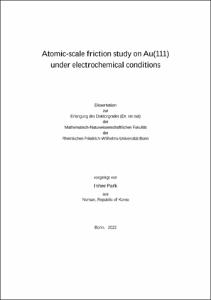Park, Inhee: Atomic-scale friction study on Au(111) under electrochemical conditions. - Bonn, 2022. - Dissertation, Rheinische Friedrich-Wilhelms-Universität Bonn.
Online-Ausgabe in bonndoc: https://nbn-resolving.org/urn:nbn:de:hbz:5-67867
Online-Ausgabe in bonndoc: https://nbn-resolving.org/urn:nbn:de:hbz:5-67867
@phdthesis{handle:20.500.11811/10248,
urn: https://nbn-resolving.org/urn:nbn:de:hbz:5-67867,
author = {{Inhee Park}},
title = {Atomic-scale friction study on Au(111) under electrochemical conditions},
school = {Rheinische Friedrich-Wilhelms-Universität Bonn},
year = 2022,
month = sep,
note = {In this study, lateral force microscopy (LFM) has been employed to investigate the frictional behavior on the surface of an electrode and the role of adsorbates, which correlates with interactions occurring at the interface. In order to focus on the frictional behavior, it is advantageous to choose well known electrochemical systems and the metal underpotential deposition (UPD) is a suitable candidate. Basically, the UPD of a foreign metal on an electrode occurs due to the strong interaction between foreign metal ion and the substrate. Thus, this reaction happens at a potential far positive of the Nernst equilibrium potential where the bulk deposition takes place. On the basis of what is already known from earlier works, using LFM, it was our aim to understand the influence of adsorbates on friction during metal UPD.
During Ag UPD on Au(111), the structure of sulfate is very sensitive with the coverage of silver and the measurement of friction forces as function of potential also reveals the relation between the coverage and friction. Thus, friction increases with coverage of Ag until the coverage arrives at a critical value (0.27 V vs. Ag/Ag+) but decreases again as the coverage is getting close to 1.
The results observed during Ag UPD on I-modified Au(111) in aqueous electrolyte show that the tip penetrates adsorbates (e.g. iodine and silver), which influences on friction. Since the iodine structures are re-observed as a normal load decreases, there is no irreversible wear. The results observed during Ag UPD on I-modified Au(111) in G4-electrolyte is quite similar with that observed on I-modified Au(111) in aqueous electrolyte and there is an influence of water on friction. Thus, the increase of friction due to the penetration into the adlayers increases with the concentration of water in the electrolyte but it is not proportional to the concentration of water. Therefore, we suggest that water adsorbed on the tip strongly interact with silver adlayer after the penetration of the tip. Interestingly, no dramatic increase of friction was observed in PC-electrolyte after the penetration. This suggests that there is an interaction between tip and PC molecules, which cancels out the influence of water on friction. During Cu UPD on bare and I-modified Au(111), friction increases with increasing the coverage of copper regardless of co-adsorbed anions. Multiple stick-slips is observed only on a Cu monolayer as normal load increase, which suggests that sliding tip strongly interacts with a Cu monolayer or the tip is stuck on the large barrier between copper atoms due to the large mismatch between Cu and Au (11%).},
url = {https://hdl.handle.net/20.500.11811/10248}
}
urn: https://nbn-resolving.org/urn:nbn:de:hbz:5-67867,
author = {{Inhee Park}},
title = {Atomic-scale friction study on Au(111) under electrochemical conditions},
school = {Rheinische Friedrich-Wilhelms-Universität Bonn},
year = 2022,
month = sep,
note = {In this study, lateral force microscopy (LFM) has been employed to investigate the frictional behavior on the surface of an electrode and the role of adsorbates, which correlates with interactions occurring at the interface. In order to focus on the frictional behavior, it is advantageous to choose well known electrochemical systems and the metal underpotential deposition (UPD) is a suitable candidate. Basically, the UPD of a foreign metal on an electrode occurs due to the strong interaction between foreign metal ion and the substrate. Thus, this reaction happens at a potential far positive of the Nernst equilibrium potential where the bulk deposition takes place. On the basis of what is already known from earlier works, using LFM, it was our aim to understand the influence of adsorbates on friction during metal UPD.
During Ag UPD on Au(111), the structure of sulfate is very sensitive with the coverage of silver and the measurement of friction forces as function of potential also reveals the relation between the coverage and friction. Thus, friction increases with coverage of Ag until the coverage arrives at a critical value (0.27 V vs. Ag/Ag+) but decreases again as the coverage is getting close to 1.
The results observed during Ag UPD on I-modified Au(111) in aqueous electrolyte show that the tip penetrates adsorbates (e.g. iodine and silver), which influences on friction. Since the iodine structures are re-observed as a normal load decreases, there is no irreversible wear. The results observed during Ag UPD on I-modified Au(111) in G4-electrolyte is quite similar with that observed on I-modified Au(111) in aqueous electrolyte and there is an influence of water on friction. Thus, the increase of friction due to the penetration into the adlayers increases with the concentration of water in the electrolyte but it is not proportional to the concentration of water. Therefore, we suggest that water adsorbed on the tip strongly interact with silver adlayer after the penetration of the tip. Interestingly, no dramatic increase of friction was observed in PC-electrolyte after the penetration. This suggests that there is an interaction between tip and PC molecules, which cancels out the influence of water on friction. During Cu UPD on bare and I-modified Au(111), friction increases with increasing the coverage of copper regardless of co-adsorbed anions. Multiple stick-slips is observed only on a Cu monolayer as normal load increase, which suggests that sliding tip strongly interacts with a Cu monolayer or the tip is stuck on the large barrier between copper atoms due to the large mismatch between Cu and Au (11%).},
url = {https://hdl.handle.net/20.500.11811/10248}
}






